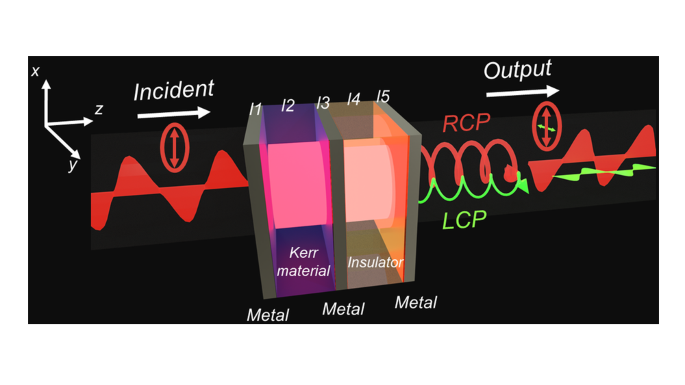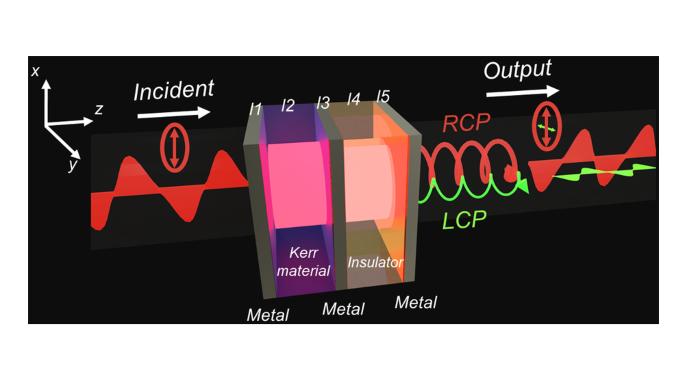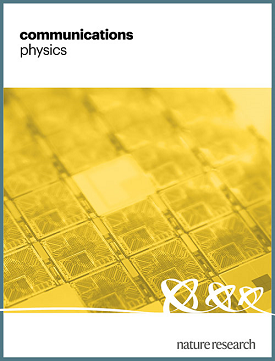法布里-佩罗特耦合纳米腔体的自发对称破缺
IF 5.4
1区 物理与天体物理
Q1 PHYSICS, MULTIDISCIPLINARY
引用次数: 0
摘要
环形空腔正迅速成为研究自发对称破缺的首选平台。然而,关于克尔耦合空腔内手性极化分裂的研究还处于初步阶段。在这里,我们通过实验观测到了非赫米提耦合法布里-佩罗特纳米空腔中的自发对称性破缺。在实验中,水平偏振光入射到纳米腔上,当功率超过对称性破缺阈值(8\,{{mb/ox{mW}}})时,对称性破缺就会发生。我们通过非线性耦合模式理论来解释这种观察结果,发现在共振峰出现了依赖于激发功率的左右手圆极化随机分裂(分别为 RCP 和 LCP)。进一步的数值模拟表明,当入射功率高于对称性破缺阈值时,器件会表现出自发对称性破缺特性:当输入场为单极化时,输出场中会出现一个额外的极化分量,这归因于 RCP 和 LCP 的不平衡。我们的研究结果让人们进一步了解了非赫米提系统中的自发对称性破缺,并展示了所提器件在光信号处理中的潜在应用。本文章由计算机程序翻译,如有差异,请以英文原文为准。


Spontaneous symmetry breaking of coupled Fabry–Pérot nanocavities
Ring cavities are quickly emerging as preferential platforms to investigate spontaneous symmetry breaking. However, research on handedness polarisation splitting within Kerr-coupled cavities is yet at a preliminary stage. Here, we observe experimentally spontaneous symmetry breaking in a non-Hermitian coupled Fabry‒Pérot nanocavity. In the experiment, horizontally polarised light is incident on the nanocavities, and symmetry breaking occurs when the power exceeds the symmetry breaking threshold of $$8\,{{\mbox{mW}}}$$ . We interpret such observation via nonlinear coupled mode theory, finding that an excitation power-dependent random splitting of right- or left-handed circular polarisations (RCP and LCP, respectively) emerges at the resonance peak. Further numerical simulations show that when the incident power is above the symmetry breaking threshold, the device exhibits spontaneous symmetry breaking characteristics: an additional polarisation component appears in the output field when the input field is monopolarised, and this is attributed to the imbalance of RCP and LCP. Our findings provide further understanding of spontaneous symmetry breaking in non-Hermitian systems and demonstrate the potential applications of the proposed device in optical signal processing. Synchronization between self-sustained oscillators is ubiquitous in nature and engineering, and it is generally accepted to occur due to weak interactions between the oscillating objects. The authors challenge this paradigm by presenting a theoretical higher-order phase model for non-weak coupling validated through experiments.
求助全文
通过发布文献求助,成功后即可免费获取论文全文。
去求助
来源期刊

Communications Physics
Physics and Astronomy-General Physics and Astronomy
CiteScore
8.40
自引率
3.60%
发文量
276
审稿时长
13 weeks
期刊介绍:
Communications Physics is an open access journal from Nature Research publishing high-quality research, reviews and commentary in all areas of the physical sciences. Research papers published by the journal represent significant advances bringing new insight to a specialized area of research in physics. We also aim to provide a community forum for issues of importance to all physicists, regardless of sub-discipline.
The scope of the journal covers all areas of experimental, applied, fundamental, and interdisciplinary physical sciences. Primary research published in Communications Physics includes novel experimental results, new techniques or computational methods that may influence the work of others in the sub-discipline. We also consider submissions from adjacent research fields where the central advance of the study is of interest to physicists, for example material sciences, physical chemistry and technologies.
 求助内容:
求助内容: 应助结果提醒方式:
应助结果提醒方式:


